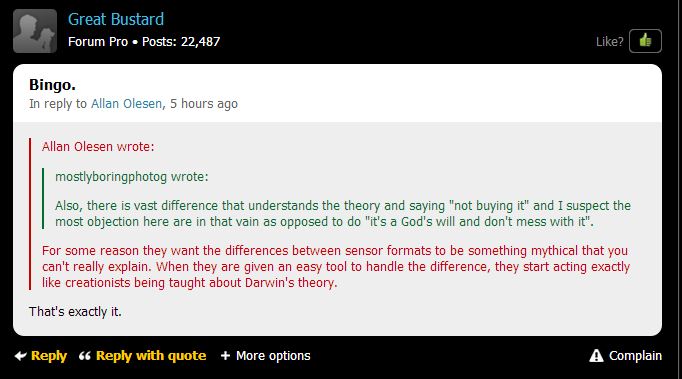 Originally posted by jsherman999
Originally posted by jsherman999 
You can certainly go into these purchases completely blind instead, but that's a lot of money to spend that way, and disappointment lurks around every corner. On the fora we do sometimes see FF or m43 or 1'' buyers lamenting the negative IQ 'surprises' they encounter.
That's one of the false assumptions that "equivalence" supporters would want us to believe, that we either use it or we have nothing. Yeah, right.
As eyeswideshut said - and I agree wholeheartedly - "equivalence" only works if you want "to contemplate recreating an equivalent image, dof included". That's an assumption which must be proved true.
Another assumption, is that you have a baseline. "A 50mm f/1.4 on m4/3 is equivalent to a 100mm f/2.8 on FF" is a pretty much useless information, if you don't have a clue how any of them looks like. You'd end up cluelessly paper-comparing lenses, an equivalent of buying cameras based on DXOMark scores (and since you're there, you can combine the two).
A most annoying assumption, is that "equivalence" is the best way of comparing the included parameters. Point 2) mentions noise, and "equivalence" should give you some computed score about it via "total light". But "equivalence" does not differentiate between any cameras of the same format! The old 5D or the brand new D810, they're all the "same" ("equivalence" works within the assumption that all sensors are the same, which is completely and totally untrue). But what better way could there be? Is it even possible, after all we have those nice formulae which appears scientific and such?
Sure: use your own eyes! There are plenty of review sites with sample images taken in near-identical conditions; you can look at them and observe, which image is noisier, how's the quality of noise and much more than that. Since photography is a visual art, you'll get more information this way (even if you'll get less numbers).
4) is another point where "equivalence" is useless and even dangerous. Don't sell your lenses based on some numeric computations! Try to
use them, see by experience if you're OK with their new role - sell them if you're not.
You might discover that you like them better instead of wanting them to be "equivalent lenses", and I know many FA Limited (and other "full frame" K-mount lenses) owners waiting for a Pentax "full frame" camera will agree with me.
5) is debatable, what's a DOF advantage? I guess it's assumed to be the capacity to offer a shallower DOF, but that's not true for every usage.
6) You cannot compute the image quality loss using angle of view and DOF, that's ridiculous.
As above, you will find it by simply looking at image samples. Perhaps with your usage you'll find out nothing compels you to jump from APS-C to "FF". Perhaps you'll get an immediate and significant benefit. There is no single answer.
Seeing is the most powerful tool we have, and it irks me when equivalentionists are equating it to being "completely blind" - trying to teach unsuspecting people to do the same. They're the ones blinded by some silly numbers.


 Similar Threads
Similar Threads 






 ) are probably dealing with our minds. Here is one of these matters, which I also deal in relation to equivalence topic:
) are probably dealing with our minds. Here is one of these matters, which I also deal in relation to equivalence topic:







 Post #8 by TonyNorthrup
Post #8 by TonyNorthrup








